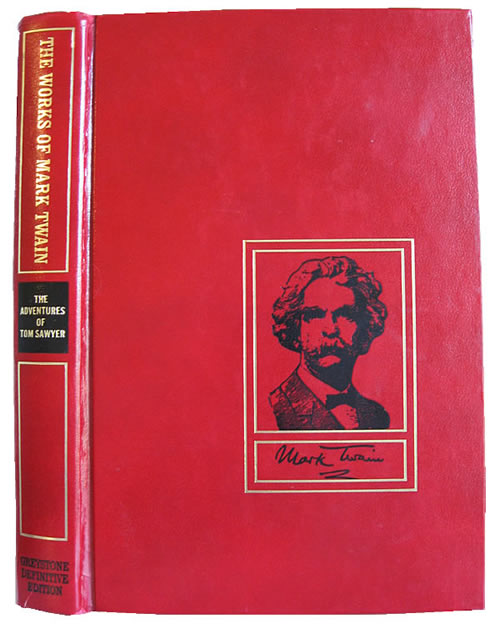
History and Description
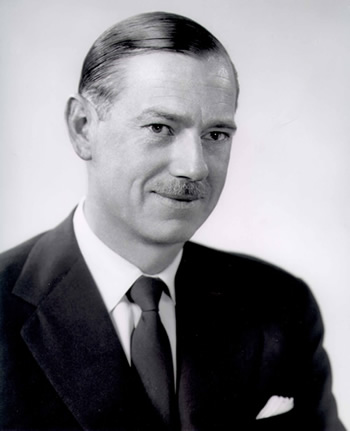 John Alun Stevenson (b. 1916 - d. 2002), head of Greystone Corporation, had been the financial whiz kid behind the American Artists edition of the 1930s. Photo courtesy of Susan Brown and David Bonner. |
John Alun Stevenson, head of Greystone Corporation, achieved tremendous success as a direct marketer with sales based on continuity selling. He had previously been involved in distributing the American Artists edition and the Authorized Edition of Mark Twain's works in the 1930s via newspaper continuity programs which began with the New York Post. According to Cecil Hoge, author of Mail Order Know-How, "John was a master of complex mail order that few people in mail order understood as well as he did" (Hoge, p. 157). |
Stevenson once described how he selected sets of books for publication, "Advance editorial costs came first. The least (immediately) expensive way to secure editorial was to find an existing set and pay royalties" (Hoge, p. 157). The old Gabriel Wells Definitive Edition of Mark Twain's works and the Stormfield Edition of 1929 contained the array of titles that could be offered via a Greystone sales campaign. According to former Greystone sales director Richard Landsman, the fiftieth anniversary of Mark Twain's death had received some notice and by the mid 1960s Hal Holbrook was achieving recognition for his performances in Mark Twain Tonight. Mark Twain was still in the public eye and most of his works were then in public domain. Only a small amount of royalties were required from Harper and Row. Thus, the Greystone Definitive Edition of the Works of Mark Twain took shape. An ad in the September 10, 1967 book section of The New York Times featured an endorsement from Cyril Clemens, an offer of a free book, and spelled out the terms and the process for acquiring a complete set. Each volume was bound in red simulated leather and featured gold Lustrofoil stamping. The tops of each page and the front side were dyed in matching red.
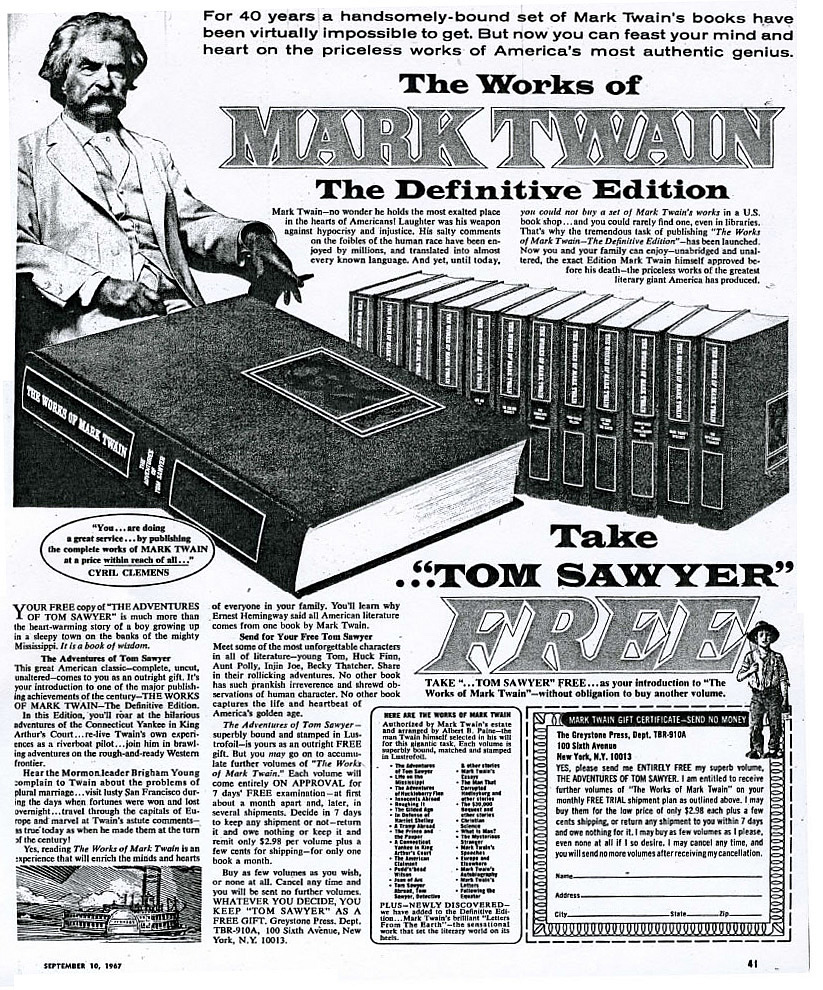
A closer look at the details of the Greystone continuity program indicates that after one free book -- The Adventures of Tom Sawyer -- a customer would receive on approval a book each month which they could keep for $2.98 or return if they did not want it. A customer could buy as many or a few books from the set as they chose.
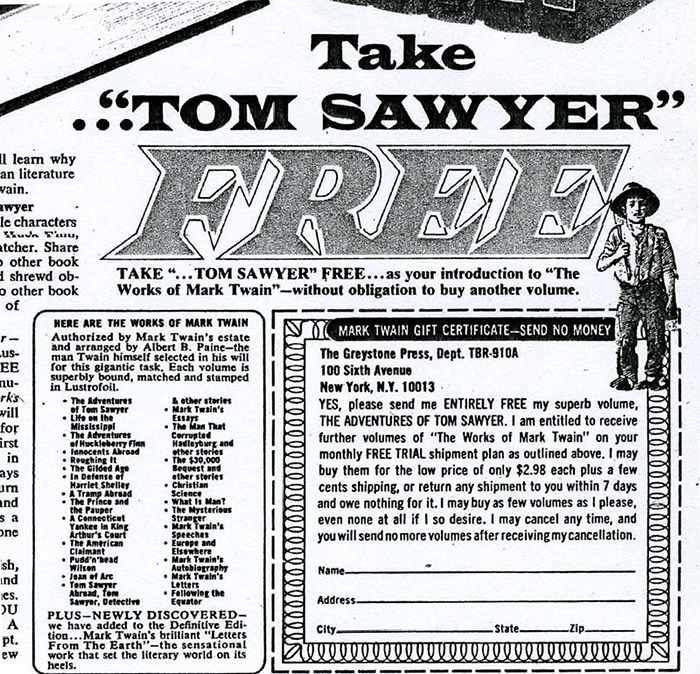
The twenty-six titles originally advertised in the Greystone Definitive Edition were:
The volume titled In Defense of Harriet Shelley was alternately titled Literary Essays. Not listed in the above ad is Sketches New and Old which was also included. Mark Twain's Letters comprises two volumes -- bringing the total number of volumes in a complete set to twenty-seven. The Greystone Definitive Edition was the first uniform edition to include Letters From the Earth which had originally been published about five years earlier in 1962. The Greystone Edition features none of the full page illustrations of the Gabriel Wells Definitive Edition or Stormfield Edition but does retain the introductory Appreciations by noted authors of their day along with the Introductions written by Albert Bigelow Paine.
Racial Tensions of the 1960s and the End Papers
While the Gabriel Wells Definitive Edition and the Stormfield Edition were the basis for the contents of the Greystone Definitive Edition, the end papers for the Greystone Definitive Edition were derived from the old American Artists end papers that had originally been drawn by Franklin Booth. Richard Landsman recalled he still had a few volumes of the American Artists set at the time and that John Stevenson used those end papers to create new ones for the Greystone Definitive Edition. Booth's original end papers feature characters from Mark Twain's works including the slave Jim from Adventures of Huckleberry Finn. In the Greystone Definitive Edition, Jim has been completely erased from the end papers and replaced by the character of the astrologer based on the one drawn by N. C. Wyeth for The Mysterious Stranger. The fictional character of the astrologer was, in fact, a creation of Mark Twain's biographer Albert Bigelow Paine and Harper editor Frederick Duneka. (See the discussion on The Mysterious Stranger in the Gabriel Wells Definitive Edition for more on this topic.) Although the full extent of the literary fraud and tampering of manuscripts was published by Mark Twain scholar John Tuckey in 1963, the Greystone book designers apparently were unaware of the revelation or chose to ignore it.
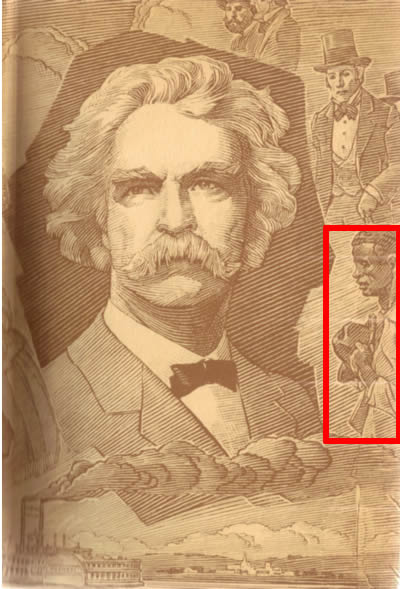 End papers from the American Artists Edition of the 1930s featuring the slave Jim from Huckleberry Finn |
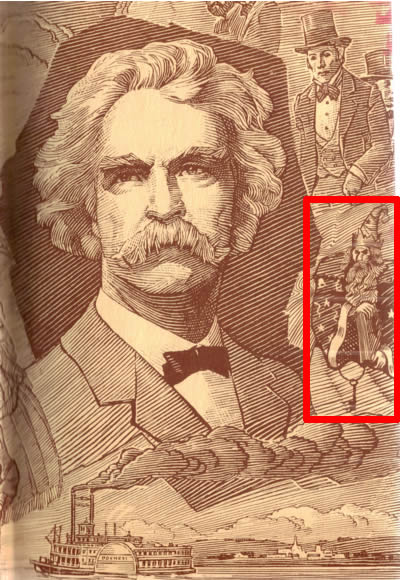 Greystone end papers with Jim replaced by the astrologer |
This alteration in illustrations is a reflection of the racial tensions of the 1960s and the controversy some of Mark Twain's works were generating. On December 7, 1966 The New York Times published a story on the Huckleberry Finn controversy underway at the University of Massachusetts. The portrayal of blacks in American literature and in Mark Twain's works was a sensitive political topic. Greystone's book designer from 1959 -1974 was Harold Franklin. Franiklin had been heavily involved in producing The Negro Heritage Library for Educational Heritage Inc. in 1966. No evidence has been found indicating Franklin was the person responsible for erasing Jim from the end papers of the Greystone Definitive Edition, but Franklin's later literary career indicates a keen interest in and awareness of racial issues. Franklin, of Jewish heritage with an original surname of Feigenbaum, was born August 4, 1920 in Detroit and died July 25, 2000 in Delray Beach, Florida. His works include the plays "General Moses" -- a play for young people about black American Harriet Tubman and "First to Die" -- a one act play about Crispus Attucks. Both plays were published by Youth Discovers in 1971.
How the Sales Fared
In continuity marketing programs, a large number of interested readers will likely sign up to receive a free volume. A large number of books at the beginning of the series might be sold, but fewer sets are likely to be completed. Readers can start and stop at any point in time and return books they do not want. Fewer copies of titles offered late in the series are likely to be printed compared to titles offered relatively early in the program. According to sales director Richard Landsman, the Greystone Definitive Edition was a mixed success with schools and libraries being the biggest customers while the general public was described as "indifferent." Sales of the Greystone Definitive Edition were discontinued after about a year. Today complete sets of the Greystone Definitive Edition are scarce but hold relatively little appeal to serious book collectors.
_____
Summary of Features of the Greystone Definitive Edition
_____
Bonner, David. Personal correspondence, 1 August 2011.
Commire, Anne. Something About the Author, Volume 13, (Gale Research Company, 1978).
Hoge, Cecil C., Sr. Mail Order Know-How, (Ten Speed Press, 1982).
James C. Jernigan Library, Texas A&M University, Kingsville, Texas. Online catalog description. Accessed 3 March 2012.